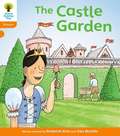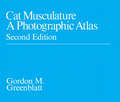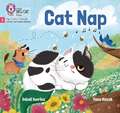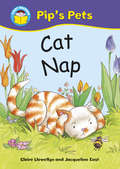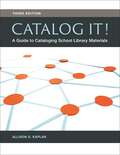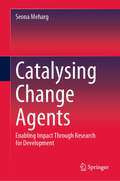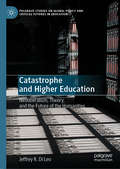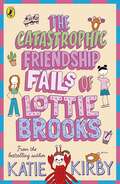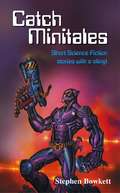- Table View
- List View
The Castle Garden: Floppys Phonics (Book Band 6 Orange)
by Roderick HuntAnneena writes a fairy tale about a princess called Tara. Focus phonics:
Castle in the Classroom: Story as a Springboard for Early Literacy
by Ranu BattacharyyaHere is my wish for all young childrenthat they too can experience a class as inspiring as Ranu's. Here is my wish for all teacherswhen you read The Castle in the Classroom, let Ranu's wise teaching be your guide. Georgia Heard ' The Castle in the Classroom describes a year in a kindergarten classroom as the children embark on literary exploration. Each child approaches the journey from a different perspectivesome are self-sufficient, others more hesitant; some are literary adventurers, others shyly reluctant. The detailed focus lessons throughout the book use the power of storiespersonal narratives,' folktales, and fairy talesto deepen the literary experience so that reading and writing become as much a part of kindergarten as playing and pretending are. As the book progresses through the year, teachers will find a wealth of resources, including practical models to teach strategies and skills; effective teaching schedules; ways to address, challenge, expand, and celebrate student learning; examples of student work; parent education materials; and ideas on how to manage assessment. By the end of the year, your studentslike those in Ranu's classwill have built on their love of storytelling to establish a strong literacy foundation.
Castle in the Classroom: Story as a Springboard for Early Literacy
by Ranu BattacharyyaHere is my wish for all young childrenthat they too can experience a class as inspiring as Ranu's. Here is my wish for all teacherswhen you read The Castle in the Classroom, let Ranu's wise teaching be your guide. Georgia Heard ' The Castle in the Classroom describes a year in a kindergarten classroom as the children embark on literary exploration. Each child approaches the journey from a different perspectivesome are self-sufficient, others more hesitant; some are literary adventurers, others shyly reluctant. The detailed focus lessons throughout the book use the power of storiespersonal narratives,' folktales, and fairy talesto deepen the literary experience so that reading and writing become as much a part of kindergarten as playing and pretending are. As the book progresses through the year, teachers will find a wealth of resources, including practical models to teach strategies and skills; effective teaching schedules; ways to address, challenge, expand, and celebrate student learning; examples of student work; parent education materials; and ideas on how to manage assessment. By the end of the year, your studentslike those in Ranu's classwill have built on their love of storytelling to establish a strong literacy foundation.
Castles (Tristars, Series B) (PDF)
by William O'ByrneThis non-fiction book explains how castles have been made in different ways over the years. It also describes their weaknesses and how people were able to attack them thus leading to changes in design.nbsp;
Castles (Tristars, Series B) (PDF)
by William O'ByrneThis non-fiction book explains how castles have been made in different ways over the years. It also describes their weaknesses and how people were able to attack them thus leading to changes in design.nbsp;
A Cat (A Series #Book 1)
by Marlene GreenwoodLearn to read with Jelly and Bean: AB Starter Pack with New Words 1A a cat: a on cat mat hat 1B a man: man hot cot 2A a box: in big box 2B a bat: and bat bin tin 3A a dog on a log: dog log frog 3B a bad dog: bad mad 4A cats in the mud: the bed mud tub rug 4B a bug in a cup: bug cup bun hop pan nut
Cat And Dog In A Mess (Collins Big Cat Phonics Ser. (PDF))
by Shoo Rayner Cliff Moon Collins Big Cat StaffWhen Cat and Dog play in the park, Dog gets into a mess. Cat tries to tidy him up, but ends up getting even messier! This funny story features the lively characters Cat and Dog. Red / Band 2A - A simple story with a familiar setting Text type - Fiction The focus phonemes in this book are e, s and c (ck). Other phonemes practised are a, t, i, n ,c, o, r, m, d, g, u, l, h ,f and b. The character profiles on the final spread help children compare and contrast Cat and Dog. Shoo Rayner also wrote Red 2B Bot on the Moon. This story is paired with the simple non-fiction recount about cats: Red 2A Pet Cat, Big Cat. More stories about Cat and Dog can be found in Collins Big Cat guided reading series.
Cat Musculature: A Photographic Atlas
by Gordon GreenblattThis series of brilliant photographs shows the dissection of the cat musculature. It is designed for use in conjunction with the third edition of Hyman's Comparative Vertebrate Anatomy, edited by Marvalee Wake, although it can be used with other textbooks. Every possible step has been taken to make the photographs easy to interpret and to follow. Reference indications to the Wake texts are included, and also concise data on the origin, insertion, and action of each muscle. The scale is such that in most cases no more than five muscles are shown per photograph, thus simplifying the task of visualizing the individual muscles. An invaluable aid for every student of cat anatomy.
Cat Musculature: A Photographic Atlas
by Gordon GreenblattThis series of brilliant photographs shows the dissection of the cat musculature. It is designed for use in conjunction with the third edition of Hyman's Comparative Vertebrate Anatomy, edited by Marvalee Wake, although it can be used with other textbooks. Every possible step has been taken to make the photographs easy to interpret and to follow. Reference indications to the Wake texts are included, and also concise data on the origin, insertion, and action of each muscle. The scale is such that in most cases no more than five muscles are shown per photograph, thus simplifying the task of visualizing the individual muscles. An invaluable aid for every student of cat anatomy.
Cat Musculature: A Photographic Atlas
by Gordon GreenblattThis series of brilliant photographs shows the dissection of the cat musculature. It is designed for use in conjunction with the third edition of Hyman's Comparative Vertebrate Anatomy, edited by Marvalee Wake, although it can be used with other textbooks. Every possible step has been taken to make the photographs easy to interpret and to follow. Reference indications to the Wake texts are included, and also concise data on the origin, insertion, and action of each muscle. The scale is such that in most cases no more than five muscles are shown per photograph, thus simplifying the task of visualizing the individual muscles. An invaluable aid for every student of cat anatomy.
Cat Musculature: A Photographic Atlas
by Gordon GreenblattThis series of brilliant photographs shows the dissection of the cat musculature. It is designed for use in conjunction with the third edition of Hyman's Comparative Vertebrate Anatomy, edited by Marvalee Wake, although it can be used with other textbooks. Every possible step has been taken to make the photographs easy to interpret and to follow. Reference indications to the Wake texts are included, and also concise data on the origin, insertion, and action of each muscle. The scale is such that in most cases no more than five muscles are shown per photograph, thus simplifying the task of visualizing the individual muscles. An invaluable aid for every student of cat anatomy.
Cat Nap: Pip's Pets: Cat Nap (Start Reading: Pip's Pets)
by Claire LlewellynStart Reading is a new series of highly enjoyable books for beginning readers at KS1. They have been carefully graded to correspond to the Book Bands now widely used in schools. This enables readers to be sure that they choose books that match their own ability. There is very careful and gentle graduation from Band to Band. The books can be shared with an adult or read independently. They promote the enjoyment of reading through reading real, satisfying stories with a beginning, a middle and an end. This is a series of 4 books at band 3 of the Start Reading programme. Pip's Pets is about Pip and his pets- Coco the cat, Digby the Dog, Sid and the snake and the perfect pet.
Catalog It!: A Guide to Cataloging School Library Materials
by Allison G. KaplanWhether you're a practicing cataloger looking for a short text to update you on the application of RDA to cataloging records or a school librarian who needs a quick resource to answer cataloging questions, this guide is for you.Since the last edition of this invaluable text was published, the library world has experienced a revolution in descriptive cataloging the likes of which has not been seen since the early 1980s. This updated, third edition of an established and well-respected guide makes it easy for you to stay in step with those monumental changes. The book will help you understand the latest fundamentals of cataloging so you can get items on the library shelves quickly and efficiently.Every chapter has been revised. Changes in standards, including RDA and BISAC, that were alluded to in the second edition are discussed in depth and illustrated with explanations, and sample problem sets are included so you can put theory into practice. In addition, the book provides you with clear headings for easy scanning as well as cheat sheets and templates for creating records for book and non-book items. Previous editions of this text have been used by library practitioners and library and information science professors across the country because of its spot-on, easy-to-follow guidance on cataloging for school libraries. This new edition builds upon those strengths, adding everything you need to know about current, groundbreaking changes.
Catalog It!: A Guide to Cataloging School Library Materials
by Allison G. KaplanWhether you're a practicing cataloger looking for a short text to update you on the application of RDA to cataloging records or a school librarian who needs a quick resource to answer cataloging questions, this guide is for you.Since the last edition of this invaluable text was published, the library world has experienced a revolution in descriptive cataloging the likes of which has not been seen since the early 1980s. This updated, third edition of an established and well-respected guide makes it easy for you to stay in step with those monumental changes. The book will help you understand the latest fundamentals of cataloging so you can get items on the library shelves quickly and efficiently.Every chapter has been revised. Changes in standards, including RDA and BISAC, that were alluded to in the second edition are discussed in depth and illustrated with explanations, and sample problem sets are included so you can put theory into practice. In addition, the book provides you with clear headings for easy scanning as well as cheat sheets and templates for creating records for book and non-book items. Previous editions of this text have been used by library practitioners and library and information science professors across the country because of its spot-on, easy-to-follow guidance on cataloging for school libraries. This new edition builds upon those strengths, adding everything you need to know about current, groundbreaking changes.
Catalysing Change Agents: Enabling Impact Through Research for Development
by Seona MehargThis book provides an overview of the challenges and opportunities for creating positive systemic change through research for development projects, providing four real-world examples. Practical insights are offered on identifying and cultivating change agents through your projects and programs, increasing the likelihood of enduring success. Understanding and participating in these types of interventions enable researchers and practitioners to become better agents of change themselves.
Catalyst: An evidence-informed, collaborative professionallearning resource for teacher leaders and other leaders workingwithin and across schools
by Carol Taylor Karen Spence-Thomas Chris Brown Louise StollCo-authored by Louise Stoll, Carol Taylor, Karen Spence-Thomas and Chris Brown, Catalyst: An evidence-informed, collaborative professional learning resource for teacher leaders and other leaders working within and across schools is a collection of specially designed cards created to support and promote the professional learning and development of groups of teacher leaders.Catalyst is a professional learning tool intended to bring to life the findings of a collaborative research and development project carried out between researchers at the UCL Institute of Education and Challenge Partners, an informal national network of schools. The project investigated four questions: 1. What is it about effective middle leadership within and across schools that changes teachers' practice?2. What are the most powerful ways of sharing knowledge about excellent middle leadership practice within and across schools?3. What are the most important factors when designing evidence-based tools to track changes in teachers' practice as a result of middle leaders' interventions?4. What leadership conditions in schools help develop and embed cultures of shared outstanding practice? The collection consists of two sets of resource cards and a clear and detailed facilitator guide - along with a bibliography and photocopiable resources for download - and has been designed for use by staff in schools in all contexts and across the entire student age range. Ultimately, the aim of the Catalyst process is to:help develop better understanding of and skills in teacher/middle leadershipstimulate evidence-informed conversations about teacher/middle leadership which lead to deep and meaningful learningsupport skilled facilitation of these conversationsencourage inquiry, improveproblem-solving and enrich decision-making through collaborationenhance leadership within schools and across networks and school partnerships. Suitable for school leaders and educators looking to both expand and refine their conversations around change management, professional development and school improvement.
Catalyst in Action: Case Studies of High-Impact ePortfolio Practice
by Bret EynonPublished in association with In 2017, Bret Eynon and Laura M. Gambino released High-Impact ePortfolio Practice, which drew broad acclaim from faculty and educational leaders. “An instant classic,” wrote one reviewer. “The book I’ve been waiting for!” exclaimed another. With compelling evidence of the impact of ePortfolio “done well,” and a practical framework for educators to follow, this research study quickly led to the formal recognition of ePortfolio as a validated High Impact Practice.Now, with Catalyst in Action: Case Studies of High-Impact ePortfolio Practice, Eynon and Gambino have taken the next step. The book offers 20 powerful case studies, drawn from campuses ranging from Bronx Community College to Yale University, from the University of South Carolina, to Dublin University and Arizona State.In High Impact ePortfolio Practice, Eynon and Gambino outlined the Catalyst Framework, spotlighting the strategies needed to launch, build and sustain a “high-impact” ePortfolio practice. Linking integrative social pedagogy to technology, assessment and professional development, the Catalyst Framework offers guiding principles and classroom-based ePortfolio practices that improve student success, deepen the student learning experience, and catalyze learning-centered institutional change.In Catalyst in Action, teams of faculty and college leaders detail their experiences exploring and testing the Framework on their campuses. Working with diverse groups of students in a broad range of disciplines and settings, the case study authors put Eynon and Gambino’s integrative strategies into practice. Catalyst in Action shares their findings and their insights. As higher education enters a challenging new era, it must find new ways adapt and change, to support and demonstrate student growth and development. Catalyst in Action is a powerful combination of intensive research and practical experiencing. Offering exciting new evidence and fresh new insights, Catalyst in Action will be an invaluable resource for those who wish to build student success, advance higher learning, and meet the demands of the 21st century.
Catalyst in Action: Case Studies of High-Impact ePortfolio Practice
Published in association with In 2017, Bret Eynon and Laura M. Gambino released High-Impact ePortfolio Practice, which drew broad acclaim from faculty and educational leaders. “An instant classic,” wrote one reviewer. “The book I’ve been waiting for!” exclaimed another. With compelling evidence of the impact of ePortfolio “done well,” and a practical framework for educators to follow, this research study quickly led to the formal recognition of ePortfolio as a validated High Impact Practice.Now, with Catalyst in Action: Case Studies of High-Impact ePortfolio Practice, Eynon and Gambino have taken the next step. The book offers 20 powerful case studies, drawn from campuses ranging from Bronx Community College to Yale University, from the University of South Carolina, to Dublin University and Arizona State.In High Impact ePortfolio Practice, Eynon and Gambino outlined the Catalyst Framework, spotlighting the strategies needed to launch, build and sustain a “high-impact” ePortfolio practice. Linking integrative social pedagogy to technology, assessment and professional development, the Catalyst Framework offers guiding principles and classroom-based ePortfolio practices that improve student success, deepen the student learning experience, and catalyze learning-centered institutional change.In Catalyst in Action, teams of faculty and college leaders detail their experiences exploring and testing the Framework on their campuses. Working with diverse groups of students in a broad range of disciplines and settings, the case study authors put Eynon and Gambino’s integrative strategies into practice. Catalyst in Action shares their findings and their insights. As higher education enters a challenging new era, it must find new ways adapt and change, to support and demonstrate student growth and development. Catalyst in Action is a powerful combination of intensive research and practical experiencing. Offering exciting new evidence and fresh new insights, Catalyst in Action will be an invaluable resource for those who wish to build student success, advance higher learning, and meet the demands of the 21st century.
Catastrophe and Higher Education: Neoliberalism, Theory, and the Future of the Humanities (Palgrave Studies on Global Policy and Critical Futures in Education)
by Jeffrey R. Di LeoThis book asks what it means to live in a higher educational world continuously tempered by catastrophe. Many of the resources for response and resistance to catastrophe have long been identified by thinkers ranging from Ralph Waldo Emerson and William James to H. G. Wells and Emanuel Haldeman-Julius. Di Leo posits that hope and resistance are possible if we are willing to resist a form of pessimism that already appears to be drawing us into its arms. Catastrophe and Higher Education argues that the future of the humanities is tied to the fate of theory as a form of resistance to neoliberalism in higher education. It also offers that the fate of the academy may very well be in the hands of humanities scholars who are tasked with either rejecting theory and philosophy in times of catastrophe—or embracing it.
Catastrophes and Unexpected Behavior Patterns in Complex Artificial Populations (Evolutionary Economics and Social Complexity Science #27)
by Stanislaw RaczynskiA major objective of this monograph is to present an agent-based simulation of artificial populations. The focus is on possible unexpected or catastrophic events that may spontaneously appear in simulations. A short recall of the tenets of the theory of catastrophes is given. Several examples of artificial society simulations are provided as the main topic of the book. With agent-based modeling, possible catastrophes and unexpected events in artificial populations are simulated. The book presents a new modeling and simulation tool, applied to social system simulation. The models are coded in the object- and agent-oriented language Bluesss (Blues Simulation System), related to the C++ language. The program code consists of a series of generic declarations of processes. Each of them includes a number of events that are coded in C++. At the runtime, a population of objects is generated. All the objects (agents) start to execute their own events, and interact with one another. During the simulations it is possible to observe the macro-behavior of the population, where some unexpected or "catastrophic" events occur. The examples include a stock market crash, catastrophes in extended prey–predator systems, growing organisms and cancer, epidemics, social inequality and economic decay, mass-service systems, and more. Remarks on possible simultaneous events are also included.
The Catastrophic Friendship Fails of Lottie Brooks (Lottie Brooks #2)
by Katie KirbyThe hilarious new sequel to The Extremely Embarrassing Life of Lottie Brooks by the bestselling creator of Hurrah for Gin.Lottie Brooks is back for spring term at secondary school and ready to face anything. No more trying to impress mean girl Amber. And absolutely no more being nicknamed Cucumber Girl. A lead role in the spring musical gives Lottie a chance to dazzle her mega-crush Daniel with her talent as a singing crab but it's not all singing and dancing at Kingswood High. Lottie's friendship with Molly and Jess seems to be falling apart no matter how hard she tries to keep her BFFs together. Is Lottie on track for another epic friendship fail?
Catch Minitales: Short Science Fiction stories with a sting!
by Steve BowkettThis book is part of an educational package called StoryMaker Catch Pack, which uses fiction as a resource for learning. What does Peeta do when aliens invade his planet? Why does Kane watch the skies every night of his life? How does Hector F. Payne save the world? Where can you find robots, giant rats, alien invaders, supercomputers...Catch Minitales - the Science Fiction Collection Here are 26 very short stories to fill you with wonder and excitement. Do you dare to journey through time and space?
Catch That Chicken!: Targeting the ch Sound (Speech Bubbles 2)
by Melissa PalmerArchie has stolen Charlie’s prize hat – the race is on to get it back. Catch that chicken! This picture book targets the /ch/ sound and is part of Speech Bubbles 2, a series of picture books that target specific speech sounds within the story. The series can be used for children receiving speech therapy, for children who have a speech sound delay/disorder, or simply as an activity for children’s speech sound development and/or phonological awareness. They are ideal for use by parents, teachers or caregivers. Bright pictures and a fun story create an engaging activity perfect for sound awareness. Picture books are sold individually, or in a pack. There are currently two packs available – Speech Bubbles 1 and Speech Bubbles 2. Please see further titles in the series for stories targeting other speech sounds.
Catch That Chicken!: Targeting the ch Sound (Speech Bubbles 2)
by Melissa PalmerArchie has stolen Charlie’s prize hat – the race is on to get it back. Catch that chicken! This picture book targets the /ch/ sound and is part of Speech Bubbles 2, a series of picture books that target specific speech sounds within the story. The series can be used for children receiving speech therapy, for children who have a speech sound delay/disorder, or simply as an activity for children’s speech sound development and/or phonological awareness. They are ideal for use by parents, teachers or caregivers. Bright pictures and a fun story create an engaging activity perfect for sound awareness. Picture books are sold individually, or in a pack. There are currently two packs available – Speech Bubbles 1 and Speech Bubbles 2. Please see further titles in the series for stories targeting other speech sounds.
